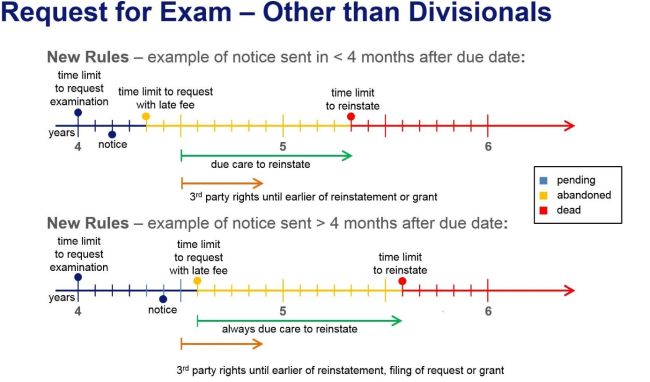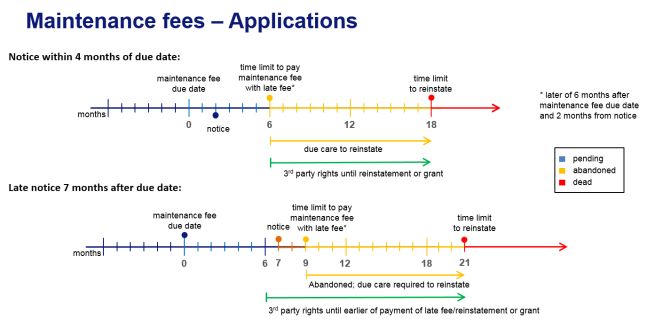In 2014, Canada’s patent law was amended to implement Canada’s obligation under the Patent Law Treaty (PLT). The final amendments to both the Patent Act and Rules came into force on October 30, 2019 (CIF).
Many of the provisions of the PLT are intended to make the law and procedure more forgiving, e.g. by reducing the minimum requirements necessary to file a patent application and obtain a filing date, and by ensuring that whenever some action is missed, a patent Applicant or Patentee is given some form of notice and/or an opportunity to make a correction. An unfortunate effect of implementing the obligations under the PLT is that many of the provisions in the Patent Act and Rules have become more complex. Timelines for making some corrections are shorter, calculation of due dates is more complex, and new concepts of “due care” and omissions being ”unintentional” have been introduced, with the exact scope of these concepts not yet clear.
With respect to obtaining a filing date, Patent Applicants should first bear in mind that each claim will bear a claim date that is either the Canadian filing date or the filing date of priority application, so delay in filing may impact claim dates. For filing a direct, non-PCT national phase Canadian patent application filed on or after CIF:
- The minimum requirements to obtain a filing date are simply: an indication that a patent is sought; a document in any language that appears to be a description; and information identifying the Applicant and enabling the Applicant to be contacted;
- Reference can be made to a previously filed application, instead of providing a description;
- The specification, or application to which reference is made, need not be in English or French on filing, but a translation will be required later;
- The translation must not include any matter not reasonably to be inferred from the original document, and any subsequent amendment must be reasonably inferred from both the original document and the translation;
- The filing fee can be paid later with a penalty fee;
- Additions to the specification and
drawings will be permitted, but note that:
a. If the addition is not disclosed in an earlier application, then the filing date will not be earlier than the date of filing of the addition;
b. If the addition is contained in a priority application and an appropriate request made then the addition will be deemed to be contained in the application as filed. - Examination must be requested within 4 years from the Canadian filing date;
- A certified copy of a priority application will now be required;
- Restoration of priority, after the standard 12 month period, is available if the failure to file within the 12 month period was ‘unintentional’;
- Where there are joint Applicants, there are complex rules determining the identity of a common representative.
For divisional applications, the basic requirements, while revised, are broadly similar to the former provisions.
National Phase Entry of PCT Applications
The filing requirements for National Phase Entry of PCT applications under the new Patent Rules remain substantially the same as those under the former Rules. For example, under both the new and former Rules, when entering the National Phase, an Applicant must submit an English or French translation of the international application at the time of National Phase Entry if the international application is not entirely in English or French and pay the basic national fee. Under the former Patent Rules, an Applicant had 30 months from the priority date of their PCT application to enter the National Phase in Canada. If the 30-month deadline was missed, the Applicant, as of right, could extend the period to enter the National Phase in Canada to 42 months by paying a late fee.
Effectively, for national phase entry applications from PCT applications with an international filing date before CIF, it is still possible to file late up to 42 months from the earliest date, as of right. For all PCT applications having an international filing date on or after CIF, under the new Patent Rules, the as of right extension to 42 months is no longer available. The 42 month extension still applies, but Applicants must now request reinstatement by submitting a statement that the failure to meet the 30-month deadline was unintentional, and pay a reinstatement fee.
What exactly will be considered “unintentional” is not clear as there is no definition of that term in the new Act or Rules. Accordingly, it is still too early to determine how the Canadian Intellectual Property Office (CIPO) will interpret this term when deciding if a PCT application should be reinstated.
For guidance, one can look to other jurisdictions that include a similar “unintentional” concept in their patent law. For example, in the U.S., the unintentional standard can be, at times, quite lenient. Often, a prompt request for reinstatement stating “the delay was unintentional” is likely to be deemed sufficient by the USPTO to revive an application. However, the longer the delay, the more likely it is that the USPTO will not accept such a simple statement and will request additional explanation that the delay truly was unintentional.
Moreover, since “unintentional” is not defined in the new Rules, it is foreseeable that Canadian Courts will be asked to review what is “unintentional” during a proceeding that seeks to invalidate a reinstated patent on that ground. Only time will tell if the Courts will give deference to an initial reinstatement decision by CIPO, or if they will routinely review “unintentional” reinstatements of National Phase Entries and allow patents to be invalidated on a finding that the reinstatement of the National Phase Entry was not “unintentional”. That being said, when looking again to the U.S. for guidance, the U.S. Courts, when asked to invalidate a patent, have been very unwilling to consider whether an abandonment was truly “unintentional” after such a finding by the USPTO.
For PCT national phase applications. There are also some new filing requirements and provisions that accelerate certain deadlines.
Applicants of PCT applications filed on or after CIF who enter the national phase in Canada now have to file a certified copy of any priority application if not already filed and accepted at the international stage. This can be done either by: (1) providing the Canadian Intellectual Property Office (CIPO) with certified copies of the priority applications; or (2) notifying CIPO that the documents are available in an accepted digital library, such as the WIPO Digital Access Service. The deadline for ‘filing’ certified copies of any priority application is the later of:
- 16 months from the earliest priority date of the priority applications;
- 4 months from the filing date of the pending application; and
- the national phase entry date (for PCT national phase applications).
For most national phase entries, no action will be needed, as the priority document will have been filed during the international phase. Moreover, no submission is required for priority documents where the priority application was filed in Canada.
For PCT applications filed on or after CIF there is now the possibility of restoring priority for Canada, either during the international (PCT) phase using the existing processes available in that system, or under the new Rules in the Canadian national phase.
For restoration of priority in the national phase, a request must be made within 1 month from national entry. To restore priority under this process, the Applicant must state that the failure to file the pending application within 12 months after the priority date of the previously regularly filed application was unintentional. Importantly, the actual priority claim still needs to be made before the earlier of (a) the end of the one month period from national entry in Canada; and (b) the later of 16 months from the earliest priority date and 4 months from the ‘filing date’, which is the PCT filing date for national phase entry applications; practically, this will mean that a timely priority claim will need to have been included in the PCT application, even if priority restoration is not requested in the international phase.
Requests for Examination
Another important change under the new Patent Rules involves the request for examination. For all applications, including PCT applications, filed on or after CIF, the new deadline to request examination will be 4 years from the filing date in Canada (or the international filing date for national phase entries of PCT applications).The deadline to request examination for divisional patent applications gets a bit more interesting, especially for the transition cases. First, for divisional patent applications filed on or after CIF, where the original parent application is filed on or after CIF, the deadline to request examination is the later of 4 years from the filing date (that is the earliest parent Canadian filing date) or 3 months from when the divisional application was actually filed in Canada (known as the presentation date).
For transition cases, however, different timelines apply. In particular, if the divisional application is filed on or after CIF, from an original parent application that was filed before CIF, then the deadline to request examination is the later of 5 years from the filing date (that is the earliest parent filing date) or 3 months from the presentation date of the divisional application.
There are some significant changes in in the new Rules regarding missed examination request due dates, notably: providing a Notice to Applicants when a request for examination is not made on time; changes to reinstatement provisions when application or patent goes abandoned for failing to request examination; and separate fees for late payment and reinstatement. Additionally, while not required by the PLT, third party rights, when examination requests are made later than six months from a prescribed date (see below), are introduced.
The charts below show the timelines for requesting examination under the new Rules with the first timeline showing a Notice issued within the first 6 months after the request for examination was due. Here, the due date for filing the request for examination and the late fee is 2 months from the Notice date. Failure to respond to the Notice will result in abandonment of the application. Reinstatement may still be made as of right until 6 months from the due date. However, any requests made after 2 months from the date of the Notice will require an additional request for reinstatement and corresponding reinstatement fee. Significantly, if the request for reinstatement is made more than 6 months past the original due date for requesting examination, the application will only be reinstated if the Commissioner determines that the failure occurred in spite of the due care required under the circumstances having been taken. The due care provisions are described in greater detail below in connection with missed maintenance fee payments.
The second timeline shows a later issued Notice, where the due date for filing the request for examination and the late payment is still calculated as 2 months from the Notice date. However since the Notice has arrived so that its 2 month period is after the expiry of the 6 months after the original examination due date, if a response to the Notice is not timely filed, the application will be abandoned and reinstatement will require a showing of due care.
Note that third party rights can arise if the examination fee for an application and a late fee are not paid within 6 months of the original due date to pay the examination fee, irrespective of whether or not the application is abandoned.

Maintenance Fees
The basic scheme for paying maintenance fees on Canadian patent applications and patents remains unchanged in many respects. Maintenance fees will still be due annually from the second anniversary, and the fee amounts remain unchanged.
There are also some significant changes in the new Rules regarding missed maintenance fee payments, notably: providing a Notice to Applicants when a maintenance fee is not paid on time; changes to reinstatement provisions when an application or patent goes abandoned for non payment of the fees; separate fees for late payment and reinstatement; and providing that the Applicant or anyone authorized by the Applicant can pay a maintenance fee and late fee (but not a reinstatement fee). Additionally, while not required by the PLT, third party rights, when fees are paid later than six months from a prescribed date (see below), are introduced.
No Notice to pay the maintenance fee will be sent by the Canadian Intellectual Property Office (CIPO) to the Applicant or Patentee. However, if the annual maintenance fee is not paid by the prescribed date, that is, on or before the anniversary of the filing date, the Commissioner must send a Notice. The Notice will state that the application will be deemed abandoned if the maintenance fee and a late fee are not paid by the later of the end of 6 months after the prescribed date and 2 months after the date of the Notice.
The following charts shows timelines for paying the maintenance fee on an application, with the first timeline showing a timely issued Notice, so that the due date for the maintenance fee and the late fee is 6 months after the prescribed date. The second timeline shows a later issued Notice, such that the due date for the maintenance fee and the late payment is calculated as 2 months from the Notice date, since the Notice has arrived so that its 2 month period is after the expiry of the 6 months after the prescribed period.
Current experience indicates that CIPO is sending out Notices of non-payment promptly, so that usually the first chart will apply and the date to pay the maintenance fee and late fee will be 6 months from the original due date.

As indicated, if the maintenance and late fees are not paid, then the application is deemed to be abandoned.
An abandoned application may be reinstated within 12 months of date of deemed abandonment, if the Applicant pays the maintenance and late fees, and also a reinstatement fee. The Applicant must also state the reasons for the failure to pay the maintenance fee. Significantly, the application will only be reinstated if the Commissioner determines that the failure occurred in spite of the due care required under the circumstances having been taken.
Due care is a new provision in Canadian patent law, and it is not yet clear what standards will apply. As the general intent of the revisions is to harmonize Canada’s laws, CIPO has advised that the applied standard will be consistent with Receiving Office guidelines under the Patent Cooperation Treaty, namely:
assess whether Patentee (and it is understood this includes all parties involved in paying a fee, e.g. the agent of record) took all measures that a reasonably prudent person would have taken, given the circumstances, to avoid the failure.
A request for reinstatement should include details of:
the circumstances that led to the failure;
the measures that the person took to avoid the failure (including any remedial or alternative steps that were taken to avoid the failure); and
any other justifications and evidence.
CIPO has indicated that an Applicant will be informed of the Office’s intended determination and given an opportunity to make observations.
For granted patents, generally the same timelines and considerations apply, and third party rights may similarly arise.
Third Party Rights
Third party rights to use the invention start at 6 months past the due date, irrespective of whether or not the application is abandoned or not. Third party rights provide a safe harbour for acts committed by third parties during prescribed periods. The intention is to provide a balance between the right of a Patentee to restore a patent, and the right of the public to rely on a publicly available information that rights have been allowed to lapse. Third party rights creates an exemption for acts, carried out in good faith, that would normally constitute infringement during the prescribed period. Note that when ‘serious and effective preparations to commit that act’ are carried out in the prescribed period, then these third party rights can extend to commission of the act after that period. Additionally, if the act or the serious and effective preparations are made in the course of a business and that business, or a relevant part of it, are subsequently transferred, then the third party rights are transferred to the transferee.
This is a new provision and it is unclear exactly how extensively it will be interpreted by the Courts. However, these third party rights may subsist for the life of the patent.
Entitlement, transfers and changes of name under the new Rules
Under the new Rules, the requirement to establish entitlement to file a patent application has not changed. However, the means to establish entitlement have changed. Current practice requires the filing of a Declaration of Entitlement, which states that the Applicant is the legal representative of the inventors. Under the new Rules the Declaration of Entitlement is replaced with a Statement of Entitlement that simply states that the Applicant is entitled to apply for a patent application. While there is no need to provide evidence of that Entitlement, Applicants are recommended to have properly executed Assignments or other agreements in place that confirm the transfer of rights from the inventors to the Applicant named on file. If there is a succession of transfers from the inventors to the Applicant, then each step along that chain of transfers should have legal confirmation of that transfer, preferably in the form of a properly executed assignment.
In addition, under the new Rules, an Applicant will be able to record the fact of a transfer instead of an recording an assignment to confirm a change of Applicant due to an assignment of rights. If the request to record a transfer is made by the transferor then all that is required is the name and address of the transferee and the recordation fee, which is currently Cdn$100. If the request to record a transfer is made by the transferee then evidence of the transfer, such as a properly executed assignment, is required.
Further, if the Applicant has changed their name, an Applicant may simply submit a request to record the name change along with the recordation fee. Evidence of the change of name change will no longer be required.
Correction of errors
The new Rules bring in an entire new regime for correcting errors made in an application and in a patent. The new provisions are intended to provide more clarity about what can be corrected and when.
Some of the most common errors made in patent applications are in the naming of the Applicants and the inventors. These errors fall into two categories under the new Rules: those that result from incorrectly identifying who the inventor or Applicant is, and those that do not. An error that results in the mis-identification of an inventor or an Applicant is, for example, naming the wrong person or entity as the Applicant, such as Bob Smith instead of John Smith, or Company X instead of Company Y. An error that does not result in the mis-identification of an inventor or an Applicant is, for example, misspelling the name of the inventor or Applicant, such as Bob Smith instead of Robert Smith, or Tesle instead of Tesla.
It is important to note that the time limits for filing a request to correct an inventor or Applicant name are now set, and in some circumstances are rather limited. For example, to correct the identity of an Applicant in a regular or convention filing, the request must be filed on or before the publication date and before a transfer request is received by the Patent Office. The provision does not apply to applications with a filing date before CIF, in which an assignment is registered. To correct the identity of an Applicant in a PCT national phase application, the request must be filed: within the later of (i) three months after national phase entry, and (ii) 3 months after notice sent by the Patent Office if they believe the person who filed the application is not the Applicant or legal representative; and before a transfer request is received by Patent Office. Requests to correct the identity of an Applicant require a statement that the error arose from inadvertence, accident or mistake, without any fraudulent or deceptive intention.
Correcting the identity of an inventor may be done any time before the day a notice of allowance is sent and, for an error that does not change the identity of the Applicant or inventor, correction may be requested anytime on or before payment of the final fee.
There appears to be no change to the mechanism to add or remove an inventor or Applicant from an application, as the provisions set out in Section 31(3) (removing Applicants) and Section 31(4) (adding Applicants) of the Patent Act remain unchanged after the CIF date.
Under the new Rules, requests to correct errors in a claimed priority date must be submitted usually before the EARLIER of 16 months from the corrected priority date and 16 months from the uncorrected priority date. Errors in name of a country, office of filing or number of a priority application in a priority request may be submitted on or before payment of the final fee.
The timing for making requests for correcting obvious errors in an issued patent have also been defined in the new Rules. For obvious errors in the patent, specification and/or drawings that were made by the Patent Office, the request for correction must be made no later than 12 months after the day on which the patent is issued. If errors in a patent were made by the Patentee, including errors in the name of the Patentee or inventor (if the correction does not change identity) and obvious errors in the specification or drawings, the request for correction must also be made not later than 12 months after the day on which the patent is issued but requires payment of a fee.
Note that obvious errors are defined as errors where what is written in the document is obviously not what was intended and that the requested correction is what was obviously intended.
In view of these shortened deadlines for correcting Applicant, inventor and priority information, it is important to make sure that the bibliographic information presented in any application or patent is checked carefully for accuracy. Further, issued patents should be checked promptly after issuance for any obvious errors as requests for correction can only be made within the first year.
The content of this article is intended to provide a general guide to the subject matter. Specialist advice should be sought about your specific circumstances.


